Explore Your Trip Day By Day
Download Your PDF Guide Now!
Day 1
Arrival in Damascus
-
-
-
-
- Arrival in Damascus Airport
- Continue to Damascus –Pick up the room at the hotel
- Overnight at the hotel
-
-
-
Day 2
Full day in Damascus
-
- Souk Al-Hamidiye : The most beautiful souk of Damascus. Its shops display all sorts of goods, especially clothes, fabrics, pastries and handicrafts.
- The Umayyad Mosque : Located in the heart of the Medina, the mosque is distinguishedby its prayer room, its courtyard and its walls covered with mosaics.
- El-Azem Palace: Not far from the Great Mosque, in the labyrinth of the souk is the palace El-Azem. It is considered as the sumptuous model of the Damascene house whose exterior simplicity and sobriety do not suggest anything about a beautiful and rich interior, with many varieties of flowers, fruit trees and water jets.
- Caravanserai: is the largest caravanserai (khān) in the Old City of Damascus. Situated along Al-Buzuriyah Souq, it was built in 1751. Khan As’ad Pasha has been described as one of the finest khans of Damascus, and the most “ambitious” work of architecture in the city.
- Straight Street (or in Latin, Via Recta): is the Roman street that runs from east to west in the old city of Damascus. It was visited by St. Paul as recorded in the book of Acts of Apostles and contains several interesting sights from the Roman, Christian and Islamic periods. Under the Greeks, the old city of Damascus was designed after the grid pattern designed by Hippodamus. Under Roman rule, the Via Recta was widened and became a colonnaded thoroughfare (documanus). These columns can still be seen today.
- Saint Ananian Church: It is of particular importance because it is attached to the memory of Saint Paul. Before his conversion to Christianity he had a vision here that blinded him for several days and gave him an unshakeable faith.
Day 3
Damascus – Sednaya Prison-Idlib-Dead cities
-
-
- Breakfast at the hotel.
- Departure to Saydnaya Military Prison: is located 30km north of Damascus, Syria. The prison became notorious for the use of torture and excessive force for both peaceful opponents of the authorities as well as military personnel suspected of opposing the regime.
- Continuation to Idlib city : is one of the first Syrian governorates to rise up against Bashar al-Assad’s regime in 2011It was the stronghold of the Syrian opposition that overthrew the Assad regime
- Dead cities: Its construction dates back to the period between the first and seventh centuries AD, and sometimes until the 10th century, and it is one of the important areas in the history of Christianity, the most important is: St. Simeon Church – Barad – Al-Bara – Qalb Lozeh – Sergila.
-
Day 4
Aleppo
-
-
- A flourishing metropolis since the 3rd millennium BC, Aleppo has been compete with Damascus for the title of the world’s oldest continuously inhabited city. The old city has undoubtedly the most beautiful souks of the Middle East.
- The souks: The old souks covered in Aleppo are distinguished by their coffered vaults and their enormous cupolas. Most date back to the 15th and 16th centuries. These are real living museums that offer us a true image of what were the commercial districts and the animation that reigned in the Middle Ages.
Each souk specializes in selling a type of product. In the charming souks you can also find authentic Bedouin handicrafts, as well as rugs, fabrics and many varieties of delicacies to enjoy, such as the famous Aleppo pistachios, honey-based pastries, almonds and fruits. dry that will make happy the most greedy. You will do the best shopping in the Orient …
- Taste Aleppo’s food!
-
Day 5
Aleppo Raqqa Deir Ezzor
-
-
-
- Breakfast at the hotel
- Departure to Raqqa: is among the Syrian cities that witnessed the worst types of destruction during the crisis.After armed groups took control of it in 2013. At the beginning of 2014, ISIS was able to tighten its control over the city and make it its capital.
- Continuation to Deir Ezzor :in eastern Syria is a region that has witnessed a turbulent history since the beginning of the Syrian revolution in 2011, as it is a critical intersection point in the Syrian conflict where multiple interests converge, including those related to the Syrian Democratic Forces and local tribes.
-
-
The Signiture Bridge of Deir Ezzor Before & After the War:
 |
Day 6
Deir Ezzor-Palmyra-Damascus
-
-
- Breakfast at the hotel
- Breakfast at the hotel. Departure to Palmyra: The one that the Romans baptized Palmyra (the city of palms) and that the Syrians call Tadmor (miracle in Aramaic) is the most important oasis of the Syrian Desert. Located 240 km from Damascus, Palmyra is the city of all superlatives.It arises in the midst of golden sands that extend to infinity. An oasis of columns remains and palm trees that testifies to the splendor of this city that made, one day, tremble Rome.
- The temple of Bel: It was for the Palmyrens what Zeus was for the Greeks. Its temple is the largest and most majestic building in Palmyra, a unique example of fusion between Greco-Roman and oriental-inspired architecture.
- The theater and the big colonnade: It crosses the city on more than one kilometer by which the caravans arriving from the desert passed by.
- Tombs: including towers tombs, tombs underground, Temple tombs and individual tombs.
- Back to Damascus – Dinner and overnight at the hotel
-
Day 7
Damascus-Bosra-Shahba-Kanawat-Sweida-Damascus
-
-
- Breakfast at the hotel.
- Departure towards Bosra
a very ancient city, already mentioned in the inscriptions of Akhenaton, in the 14th century BC. The most important of its monuments is the famous theater (2nd century AD), the one of the most beautiful and best preserved in the world. It is 45 meters long and has a depth of 8 meters. It can accommodate seventeen thousands spectators. - Continuation towards Shahba: Famous for its mosaics and monuments dating from the 3rd century A.D., Shahbais thought to be the only town in Syria the Romans built from scratch and one of the most important architectural legacies of their rule in the East.
-
-
-
- Kanawat :One of the oldest cities in the world has its monuments destroyedThe Druze reconstructed it and it became a thriving metropolisBecause of its importance, the Romans minted money in its name, but it disappeared After the Caliphate moved to Baghdad and trade routes were diverted from it
- Sweida: is an important historical symbol of resistance and revolutions in the region. The majority of its population consists of the Druze community, where the Druze constitute about 90% of the population.
- Back to Damascus & Departure to Beirut
-
Day 8
Damascus- Departure
-
-
- Breakfast at the hotel
- Transfer to Damascus airport according the schedule flight
-


































